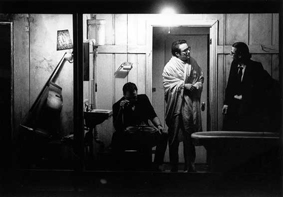


The Seven Streams of the River Ōta
© Claudel Huot
Continuously developed between 1994 and 1996, the work ultimately consists of seven sections which fully integrate characters, themes and stories which have emerged and grown during the company's international tours.
After Coriolan, Macbeth, The Tempest, The Polygraph and Needles and Opium, Robert Lepage has gone back to the genre with which he made his name in Dragon's Trilogy: the saga.
Hiroshima has grown up around and because of the river Ōta, and rarely has the concept of a saga, meandering through the years, seemed such a natural choice. This saga has taken three years to produce and is based on Japan, or rather the image of Japan as seen by other civilisations, consisting of seven tableaux which have evolved over the years - The Seven Streams of the River Ōta.
When people in Hiroshima looked into that flash, “brighter than a thousand suns”, their eyes melted and ran down their faces.In the half-century which followed, no artist or writer has been able to look directly into that instant of appalling light.
Instead, it has been refracted through innumerable lenses. Some delivered that illumination of fear -the anticipation of universal death - which coloured everything during the decades of nuclear confrontation. Other lenses broke up the light into trivial glitters to give illusions of profundity to some junk novel or television play.
At the same time, as people began more slowly to grasp the details of the Jewish Holocaust in the years immediately before Hiroshima, a second, black sun rose into which it proved impossible to look directly without being blinded. Claude Lanzman, in his film Shoah, revealed as much as is possible by using the smoked glass of personal recollections.
But nobody who has tried to confront what took place directly has survived as an artist.
Robert Lepage, in The Seven Streams of the River Ōta, is setting out to construct a masque of the later twentieth century. More precisely, he is letting this extraordinary production construct itself like a sort of coral reef, slowly changing and growing larger with each performance.
Over the whole area since the 1940s hang the white sun and the black sun, Hiroshima and Holocaust, and Robert Lepage has found that the only way to collect and transmit their glare is by filling his stage with lenses. This is made literally true, by a triumphant use of mirrors. But it is figuratively true as well.
With the heartbreaking personal narrative, the emphasis on the disguises of photography, Robert Lepage’s selection - at first violently shocking - of high farce or bed-hopping sitcom as dramatic modes are all lenses through which the unbearable light source is broken up into spectrum colours and spread out for an audience to appreciate.
In this way, Robert Lepage has made it possible to see - or to begin to see and to explore - how human culture has developed in the light of the two suns.
His drama is about survivors. But it is also about the way in which the loneliness of the survivors, the impossibility of telling others what it was like to be where they have been, has permeated all sensual experience with uncertainty and melancholy, as if generations born decades after the atom bomb and the gas chambers still carried in their genes an amazed sense of survival. The concentration camp at Theresienstadt, in which families waiting to be transported to Auschwitz were encouraged by the Nazis to develop a rich, “normal” cultural life of concerts and entertainment, prefigured this unease and this feeling of unreality.
The great flash in the Hiroshima sky, by which a city was illuminated and then instantly eradicated, is also the flashbulb of the photo-booth in which people freeze their own desires and use an image to obliterate their old identities. The encounters between cultures once mutually unknown have entirely metamorphosed the world since 1945, but these encounters seem to look back over their shoulders at the time when to be “other” - Jewish or Japanese - was to be condemned to death.
Robert Lepage, finally, is working on the idea that sexuality itself, the fact of gender and the patterns of behaviour around it, were pitched into mutation by the rays from the two suns.
This is not some easy revisiting of Eros and Thanatos, but the thought that the human species is leaving behind its old binary division altogether, exploring an entirely new range of response to love and procreation.
Where this exploration will go is as unpredictable as where Lepage’s growing, organic work of art will eventually take him - to the unknown point at which The Seven Streams of the River Ōta converge.
Neal Ascherson.
Co-production - original version
Edinburgh International Festival, Edinburgh
Manchester City of Drama
La Maison des Arts de Créteil
Wiener Festwochen, vienna
Theatreformen, Braunschweig
Change Performing Arts, Milan
IMBE Barcelona
Präsidialabteilung Der Stadt, Zurich
Aarhus Festuge
Bunkamura, Tokyo
Harbourfront Center, Toronto
Kampnagel, Hamburg
Les Productions d'Albert, Quebec
Le Centre culturel de Drummondville
Le Centre culturel de l'Université de Sherbrooke
Les Productions Spectra, Montreal
Theater der Welt, Dresden
Kobenhavn, Copenhagen
Schlossfestpiele, Ludwigsburg
Brooklyn Academy of Music, New York
Stockholms Stadsteater
Carrefour International de Théâtre, Quebec
